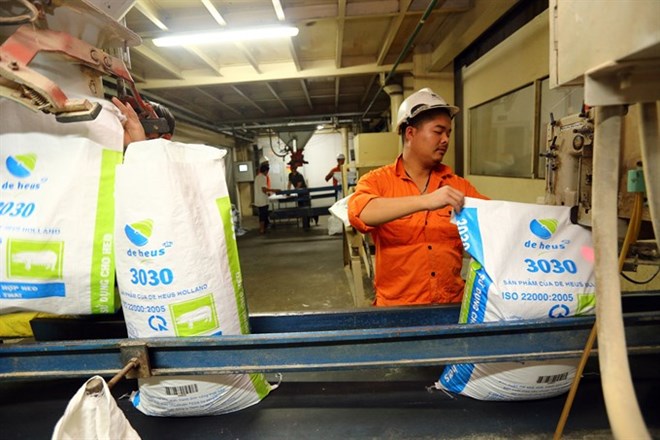Foreign firms dominate Vietnam's fast-growing animal feed industry

Animal feed packed at Netherlands - invested DE HEUS in Vinh Phuc province
The animal feed industry of Vietnam, despite being among the world’s fastest-growing by scale and output, is dominated by foreign firms while local producers are struggling to compete.
According to Nguyen Xuan Duong, deputy director of the Ministry of Agriculture and Rural Development’s Department of Livestock Production, the animal feed industry maintained two-digit growth in the past two decades, with the output jumping from 400,000 tonnes in 1993 to more than 23 million tonnes in 2016.
Vietnam is today the leading country in ASEAN and the 10th in the world in animal feed production.
However, the rapid expansion of foreign producers in Vietnam is posing threat to local firms.
Recently, the Republic of Korea’s CJ Group opened its fifth animal feed plant in Vietnam and is planning to open the sixth one this year.
A 15-million USD plant with an annual output of 500,000 tonnes in the northern province of Hai Duong was recently opened by Singapore’s HAID, which has invested in six plants throughout the country already.
Indonesia’s Java Pelletising Factory also invested 135 billion VND (5.97 million USD) in building a plant with a monthly capacity of 15,000 tonnes in Binh Dinh province - its fifth plant in Vietnam.
Thailand’s CP Group owns four animal feed plants in Vietnam, with an annual capacity of more than 400,000 tonnes each.
Uni-President from Taiwan, besides owning three plants producing fish feed of 300,000 tonnes annually, has invested 20 million USD to build another 100,000-tonne capacity plant in Quang Nam province.
Hoang Huong Giang from the ministry’s Animal Husbandry Department said there were 218 animal feed plants in Vietnam, with an average monthly capacity of 28,200 tonnes. Of these, 71 are foreign firms, with an average monthly capacity of more than 15,700 tonnes and hold a market share of some 65 percent.
Le Ba Lich, chairman of the Animal Husbandry Association of Vietnam, said local animal feed producers outnumbered foreign producers but held a market share of just some 30 percent.
Lich said the market share of local producers was in danger of narrowing down even as local producers were expanding. “It is important to adjust strategies to compete,” he said.
Many local producers are striving to cut costs and lower prices by selling directly to farmers instead of going through agents, but some have not been able to avoid losses.
Lich said foreign firms had stronger financial capacity, experience, modern production line and especially appropriate distribution strategies to expand their market.
According to Hoang Thanh Van, director of the Animal Husbandry Department, animal feed production requires high technology and huge investment, in which local producers are often weaker than FDI companies.
Doan Viet Cuong, general director of Adeco, said domestic producers must promote the export of animal feed as production capacity exceeds the local demand.
VNA
- Q1-2024, provincial socio-economic situation continues to have positive changes (24/04)
- Policy credit requires local entrusted capital source to balance (23/04)
- Creating favorable conditions for social housing buyers (23/04)
- Giant Group pours additional US$ 120 million into Binh Duong (23/04)
- Thuan An city in striving to fulfill type-1 urban criteria (22/04)
- Vietnamese furniture products introduced at Milan Design Week (21/04)
- Local real estate market strongly attracts foreign investors (20/04)
- HCM City moves towards Net Zero (19/04)
 Policy credit requires local entrusted capital source to balance
Policy credit requires local entrusted capital source to balance
 Thuan An city in striving to fulfill type-1 urban criteria
Thuan An city in striving to fulfill type-1 urban criteria
 Local real estate market strongly attracts foreign investors
Local real estate market strongly attracts foreign investors
 Firm steps of reforms
Firm steps of reforms
 Provincial enterprises are ready to join the global supply chain
Provincial enterprises are ready to join the global supply chain
 Infrastructure planning to develop modern ecosystem of modern logistics
Infrastructure planning to develop modern ecosystem of modern logistics
 Deputy Prime Minister Tran Hong Ha: Binh Duong will open a new era of green, sustainable energy development
Deputy Prime Minister Tran Hong Ha: Binh Duong will open a new era of green, sustainable energy development
 Green transformation for sustainable development
Green transformation for sustainable development
 Horasis China Meeting 2024 in Binh Duong: Opportunity for investment cooperation, promoting sustainable development
Horasis China Meeting 2024 in Binh Duong: Opportunity for investment cooperation, promoting sustainable development
 Sustainable economic development includes application of technologies, sectional planning, and environment assurance
Sustainable economic development includes application of technologies, sectional planning, and environment assurance




